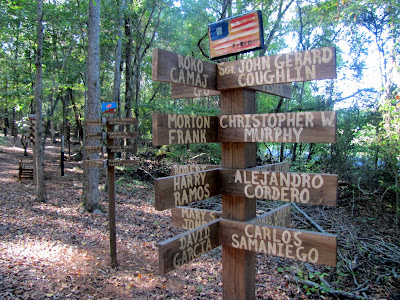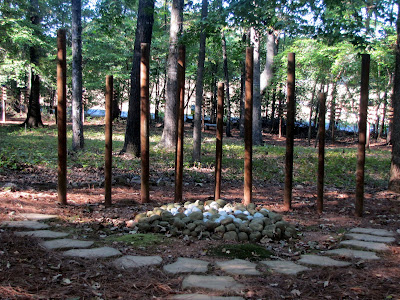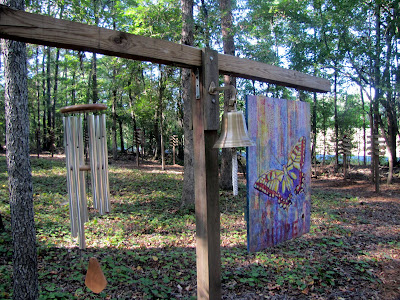The Monsters are due on Maple Street. Tweet Map
A close look at the calendar reveals that today is the 10 year anniversary of one of the marquee moments in living American’s lives. The very date of September 11 invokes an imaged of terror and death, and marks a sea change in the way we see ourselves as a people and as a nation. I feel compelled to take notice of the event as I am a red blooded American, but I shall do so in typical Baboon fashion, by telling the story of a geographical location within driving distance of Atlanta (about 1½ hours away) created by a U.S. Citizen, Georgia resident and folk artist by the name of Bob Hart near Athens. The place is called the 9-11 Memorial Garden and Trail, which is located on his property and is open to the public at 320 Morton Farm Lane in Athens GA.

Mr. Hart, a retiree from the University of Georgia, was so moved by the moments of that fateful day that he felt compelled to create something and made a personal monument to the tragedy and to the lessons which, hopefully, a grieving nation learned that September morning. It would be categorized as a folk art piece which I believe is fitting for a moment that struck a chord with every echelon of person in American Society. It is a simple trail about 300 yards in length walking through a young forest. As you enter, there is a visitor’s sign-in book and a copy of the book, Portraits: 9/11/01: The Collected "Portraits of Grief" from The New York Times , which gives a short bio of every person killed in the attacks. The construct that holds the books is adorned with two quotes from Holocaust survivor Elie Wiesel. The first reads, “Memory may be our most powerful weapon against fanaticism” and the second adds, “To live through catastrophe is bad, to forget it worse.” These sentiments are well chosen and well said to get your mind in the mood for a reflection of the events of 9-11.
, which gives a short bio of every person killed in the attacks. The construct that holds the books is adorned with two quotes from Holocaust survivor Elie Wiesel. The first reads, “Memory may be our most powerful weapon against fanaticism” and the second adds, “To live through catastrophe is bad, to forget it worse.” These sentiments are well chosen and well said to get your mind in the mood for a reflection of the events of 9-11.

The artwork itself is simple and mostly abstract, with items representing special numbers or places related to the day. As abstract art is often difficult to understand, the artist has placed several markers explaining his intentions. And they are rather straightforward, saying things like the red beam on the Pentagon Memorial represents the side that was struck by the aircraft and which was still on fire at the time of the monuments creation. There are four such special memorials along the trail: the Pentagon, the World Trade Center, Flight 93, and one to the noble concepts of Faith, Hope, and Love (this last piece has contributions from Athens artist Mary Padgelek). There are also a few other pieces of art placed throughout the trail, the most notable being an iron sculpture near the front called Migrations by local artist Harold Rittenberr. There are also several benches to sit upon for rest and reflection.

The most thought-provoking works are the signposts along the trail. They were simple wooden posts that resembled directional signs. There were 99 of them, a number chosen by multiplying the numbers in the date of the tragedy. On each sign were the hand painted names of every human being who died as a direct result of those terrorist attacks. These brought back vividly the human cost of the 10 year old event. They were people out there, like you and me, who were killed in this senseless act, and the power of a person’s name can bridge the gap between abstract and reality. Each is a person who had a job and a family and hopes and dreams. Atop each pole is a small hand painting, often of the U.S. Flag, but at other times about other concepts that should also not be forgotten like Love, Liberty, and Justice.

It would be difficult to visit such a place and not reflect on the attack on the United States, which brings me to the thoughts that swirled in my head at the memorial trail on that infamous moment and the 10 years hence. I remember the events as we all do. The feelings we all have are fairly universal; anger, sadness, fear, disgust, are all common. I was struck deeply by the days that followed. For a short while, we acted as one America in love with the country, what it stands for on its best days, and our fellow countrymen. I was so moved I even rooted for the Yankees during the November Series (and I am a baseball purist, as you know, and that is a monumental step).

But that feeling of fellowship and brotherhood drifted away from us. We let the worst parts of our collective psyche take over. We became a country filled with infighting. We became a country that trashed our 1st amendment protections, especially when it came to Muslim Americans. We became a country that was horrified to see Americans die in the destruction of iconic building, but who could make a top priority repealing a law that might keep fellow Americans dying due to lack of or inadequate healthcare. We became a country who trusted no one, and even questioned the legitimacy of birth of the person in the highest office in the land. We became a country that applauds at the mere mention of executions and that holds parties at the news of people’s deaths. We became a country that invades other countries for little or no reason, a renewed imperialism. We became a country that no longer cared about our hopes to be the beacon on a hill for all to emulate. We became a country that no longer cared about justice, right and wrong, and our fellow man, let alone our fellow citizens. I can’t help but look at the 3,000 names printed with love on the signposts and think that they would turn over in their graves, if they had graves and knew this was their legacy: that we the living, have let them down, and allowed their deaths be in vain.

So that’s the feeling I get from spending time at Bob Hart’s 9-11 Memorial Trail. They are holding a Commeration there at 6:30pm today and I encourage you to visit then, or at another time, when you can. Look at the names and look for the strength to be a better person and American. I know that this place challenged me to be just that.

There is a video you can watch here Watch.
| From 9-11 Memorial Garden |
A close look at the calendar reveals that today is the 10 year anniversary of one of the marquee moments in living American’s lives. The very date of September 11 invokes an imaged of terror and death, and marks a sea change in the way we see ourselves as a people and as a nation. I feel compelled to take notice of the event as I am a red blooded American, but I shall do so in typical Baboon fashion, by telling the story of a geographical location within driving distance of Atlanta (about 1½ hours away) created by a U.S. Citizen, Georgia resident and folk artist by the name of Bob Hart near Athens. The place is called the 9-11 Memorial Garden and Trail, which is located on his property and is open to the public at 320 Morton Farm Lane in Athens GA.
Mr. Hart, a retiree from the University of Georgia, was so moved by the moments of that fateful day that he felt compelled to create something and made a personal monument to the tragedy and to the lessons which, hopefully, a grieving nation learned that September morning. It would be categorized as a folk art piece which I believe is fitting for a moment that struck a chord with every echelon of person in American Society. It is a simple trail about 300 yards in length walking through a young forest. As you enter, there is a visitor’s sign-in book and a copy of the book, Portraits: 9/11/01: The Collected "Portraits of Grief" from The New York Times

The artwork itself is simple and mostly abstract, with items representing special numbers or places related to the day. As abstract art is often difficult to understand, the artist has placed several markers explaining his intentions. And they are rather straightforward, saying things like the red beam on the Pentagon Memorial represents the side that was struck by the aircraft and which was still on fire at the time of the monuments creation. There are four such special memorials along the trail: the Pentagon, the World Trade Center, Flight 93, and one to the noble concepts of Faith, Hope, and Love (this last piece has contributions from Athens artist Mary Padgelek). There are also a few other pieces of art placed throughout the trail, the most notable being an iron sculpture near the front called Migrations by local artist Harold Rittenberr. There are also several benches to sit upon for rest and reflection.
The most thought-provoking works are the signposts along the trail. They were simple wooden posts that resembled directional signs. There were 99 of them, a number chosen by multiplying the numbers in the date of the tragedy. On each sign were the hand painted names of every human being who died as a direct result of those terrorist attacks. These brought back vividly the human cost of the 10 year old event. They were people out there, like you and me, who were killed in this senseless act, and the power of a person’s name can bridge the gap between abstract and reality. Each is a person who had a job and a family and hopes and dreams. Atop each pole is a small hand painting, often of the U.S. Flag, but at other times about other concepts that should also not be forgotten like Love, Liberty, and Justice.
It would be difficult to visit such a place and not reflect on the attack on the United States, which brings me to the thoughts that swirled in my head at the memorial trail on that infamous moment and the 10 years hence. I remember the events as we all do. The feelings we all have are fairly universal; anger, sadness, fear, disgust, are all common. I was struck deeply by the days that followed. For a short while, we acted as one America in love with the country, what it stands for on its best days, and our fellow countrymen. I was so moved I even rooted for the Yankees during the November Series (and I am a baseball purist, as you know, and that is a monumental step).

But that feeling of fellowship and brotherhood drifted away from us. We let the worst parts of our collective psyche take over. We became a country filled with infighting. We became a country that trashed our 1st amendment protections, especially when it came to Muslim Americans. We became a country that was horrified to see Americans die in the destruction of iconic building, but who could make a top priority repealing a law that might keep fellow Americans dying due to lack of or inadequate healthcare. We became a country who trusted no one, and even questioned the legitimacy of birth of the person in the highest office in the land. We became a country that applauds at the mere mention of executions and that holds parties at the news of people’s deaths. We became a country that invades other countries for little or no reason, a renewed imperialism. We became a country that no longer cared about our hopes to be the beacon on a hill for all to emulate. We became a country that no longer cared about justice, right and wrong, and our fellow man, let alone our fellow citizens. I can’t help but look at the 3,000 names printed with love on the signposts and think that they would turn over in their graves, if they had graves and knew this was their legacy: that we the living, have let them down, and allowed their deaths be in vain.
So that’s the feeling I get from spending time at Bob Hart’s 9-11 Memorial Trail. They are holding a Commeration there at 6:30pm today and I encourage you to visit then, or at another time, when you can. Look at the names and look for the strength to be a better person and American. I know that this place challenged me to be just that.

There is a video you can watch here Watch.
Trail Essentials
Approximate Time: 1 hour
Approximate Distance: .2 miles
Features: Art Installation, Tribute to 9-11 dead, Folk art
Overall Rating: B
Scenic Quality: A
Athleticism: D
Solitude: A
Value: A
Parking: Free, but only for three cars
Hours of Operation: Doesn't close, but be respectful of property owners and neighbors
Facilities: None
Maps: Not needed
County: Clarke





